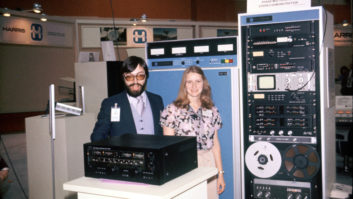Standards of FM Allocation and Interference
May 1, 2013 2:59 PM, By Jeremy Ruck, PE
This month we look at the standards of FM allocation and interference. In essence there are two main sets of standards to consider when examining the FM band in total, with a third smaller hybrid set. The first is what affects all facilities in the non-reserved or commercial portion of the band. The second is what pertains to non-commercial stations, or those in the reserved portion of the band below 92.1MHz. The third set affects those in the border region between the two portions of the band.
One of the main foci of the FCC is to ensure the fair distribution of spectrum use among the various communities. Obviously, to distribute the spectrum in such a manner requires some degree of policing to ensure, to a reasonable extent, that interference between facilities is kept to a practical minimum. While there is room for improvement in the standards due to technological advances, in practice they seem to function adequately for the most part.
An oversimplified description of interference is the overlap of specific contours. This tends to overstate the area of interference. Interference is more accurately defined as a condition where a specific ratio of signal strengths between a desired/protected and an undesired/interfering facility. In FM, these ratios exist between co-channels as well as first-, second- and third-adjacent facilities. Current ratios are the result of receiver testing performed many moons ago. The D/U protection ratios for co-channel facilities is +20dB, +6dB for first adjacencies, and -40dB respectively for second- and third-adjacent situations.
The ratios between the desired and undesired facilities remain the same regardless of the class of the protected station, although that protected signal level will vary. For all class A and the various class C flavors, the protected contour is the 1mV/m or 60dBu. For non-reserved band B1 and B facilities the protected signal level is reduced to 0.7mV/m (57dBu) and 0.5mV/m (54dBu) respectively. NCE facilities regardless of their class are protected at the 60dBu signal level. Thus for example the interference contour to a co-channel class A facility would be 40dBu, while for a second-adjacent B the relevant field strength is 94dBu.
The focus of the issue
At the heart of the commercial allocation and interference considerations is the geographic spacing table. This primary table, found in Section 73.207, details the minimum distances that must exist between facilities. The table considers these ratios above assuming flat earth or uniform terrain, and facilities at the reference height and power. For example, the minimum separation between two class A stations on the same frequency is 115km, which is obtained from the sum of the 60dBu contour distance of 28.3km, and the 40dBu interfering contour of the other station at 86.7km. The flaw in the logic is that terrain is very rarely flat and uniform at all azimuths. As a result, contour overlap can exist between fully spaced stations. The Commission has left itself an escape clause: Section 73.209.
Short spacing is permitted under Sections 73.213 and 73.215; however, the former section involves grandfathered situations, and as such we will not consider them here. Under the 215, short spacings contour protection using the above described ratios is permitted to a certain extent. The facility seeking authorization under this part may employ combinations of ERP and height reduction as well as the use of a directional antenna. Since these concepts point to other requirements, there are absolute minimum spacings that must be maintained.
There are additional considerations under 73.215. If the station to which you are short-spacing is authorized under 73.215, it is protected to its actual facilities. If the facility is fully spaced to all other facilities, implying a 73.207 authorization, then it must be protected to class reference facilities regardless of the height and power at which it is operating. In areas with wildly varying terrain this can result in a situation where it is essentially impossible to employ contour protection without significantly neutering the proposed facility. Indeed, similar anomalous behavior was one of the reasons the second-adjacent ratios were changed. As receivers became more selective, it made more sense to change the ratios, and by extension the spacing table to eliminate this problem.
– continued on page 2
Standards of FM Allocation and Interference
May 1, 2013 2:59 PM, By Jeremy Ruck, PE
In the reserved part of the band, contour protection under Section 73.509 is king. There, whatever can be shoehorned in while meeting the coverage, directional antenna, and contour protection requirements can in practice be authorized. This allows for many more stations to exist in this portion of the band, but also gave rise to some bizarre theoretical directional patterns in the 2007 filing window. However, as you approach the demarcation point between the two band segments, both situations may need to be considered. Within three channels of 92.1MHz, reserved band facilities have to meet spacing requirements to facilities on 92.1MHz and higher. To their fellow NCE facilities below 92.1MHz, contour protection must be employed.
But there’s more
The other main piece of the puzzle is the pesky intermediate frequency situation. To make things simpler, facilities separated by 53 or 54 channels must meet minimum spacing requirements. There are some very limited grandfathered exceptions to this; however, in general if you have an ERP of greater than 99W, you must take into account facilities on these channels.
Although you can use alternate propagation methods to demonstrate coverage in a more broad sense following the Skytower decision, all of this interference and overlap stuff is still based on the standard FCC model, the mechanics of which we have previously discussed. Perhaps that may someday change, however, by limiting showings to the standard model, much uncertainty and interpretation can be eliminated, thus making the job of the staff easier.
One other allocation item of interest worth discussing is the Raleigh Waiver. This concept, available only to NCE facilities, allows a station to receive contour overlap, while not causing it. It applies only on second- and third-adjacent channel situations where the interference area is vastly smaller than the gain in the coverage area. While this can obviously enhance coverage of your facility, be aware it is not a one-sided deal, and the other station can also potentially overlap, so be sure to have your consulting engineer consider that situation before heading in that direction.
To round out the discussion from this month, two examples are provided. The first illustrates a situation where two actual fully spaced facilities wind up resulting in prohibited contour overlap. The second illustrates a contrived contour overlap situation, and how the interference area by the FCC model is not necessarily the same as the overlap area.

Two fully spaced facilities can have actual interference overlap

Actual contour overlap does not match the FCC model
May 2013
WKSU designs to handle noise, wireless site connectivity, Field Reports from Deva and Worldcast APT, 20 years of Radio magazine and some NAB review….












